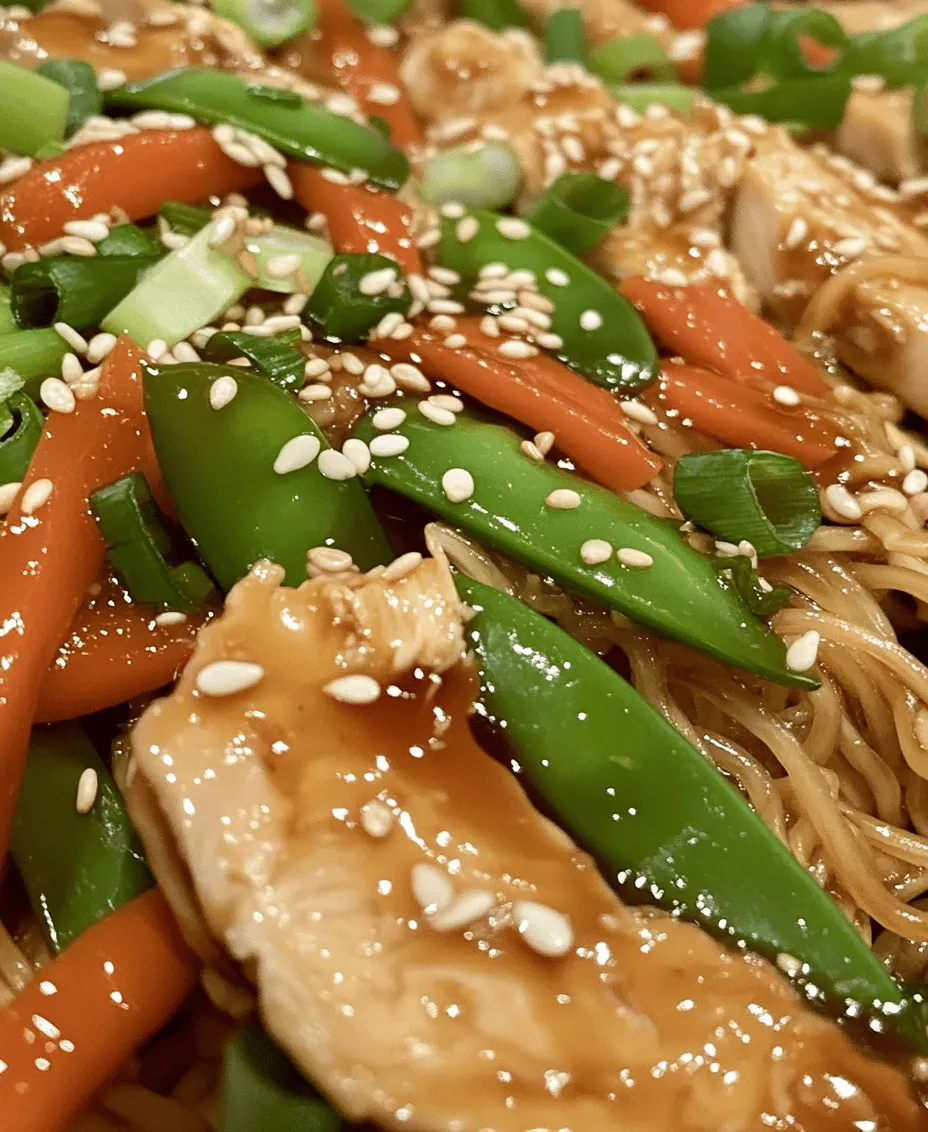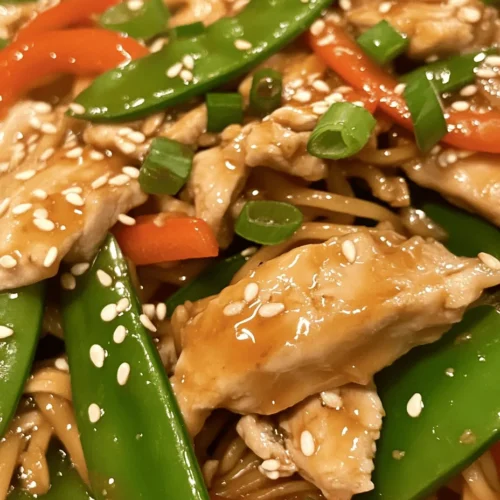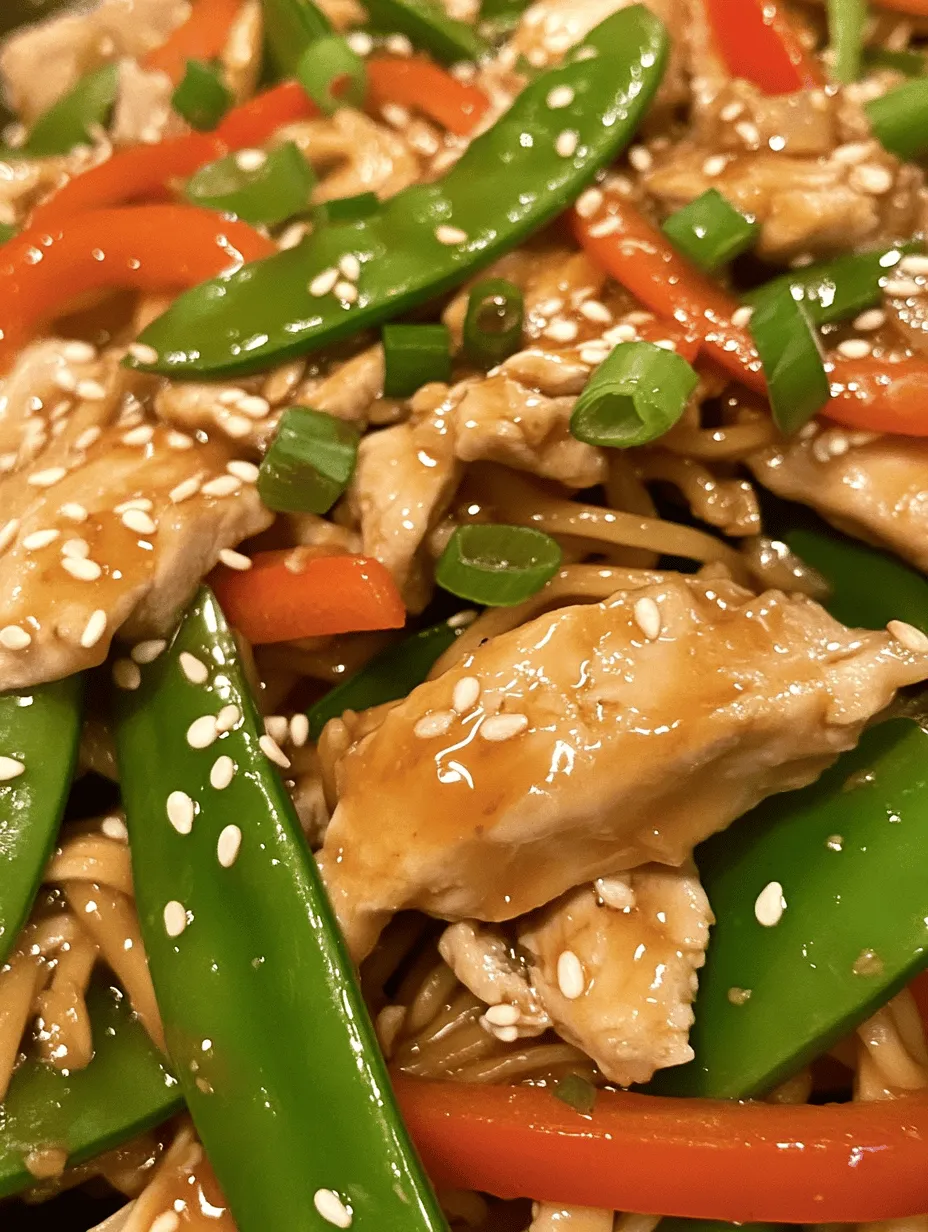Introduction
Chicken Chow Mein is more than just a dish; it’s a beloved staple in Asian cuisine that has captured the hearts and taste buds of food enthusiasts around the world. Known for its harmonious blend of flavors and satisfying textures, this dish combines tender chicken, crisp vegetables, and savory noodles, all enveloped in a rich and flavorful sauce. The beauty of Chicken Chow Mein lies not only in its delightful taste but also in its versatility. Whether you’re cooking for a weeknight family dinner or entertaining guests, this recipe offers the convenience of a quick yet impressive meal prepared from the comfort of your own kitchen.
One of the standout features of this Chicken Chow Mein recipe is the best chow mein sauce you’ll ever make. This sauce elevates the dish to new heights, infusing it with a perfect balance of salty, sweet, and umami flavors that will have everyone reaching for seconds. By using fresh ingredients and customizing the dish to your taste, you can create a chow mein that reflects your culinary preferences, making it a perfect option for any occasion.
Understanding Chow Mein
Chow Mein, which translates to “stir-fried noodles” in Mandarin, has its roots deeply embedded in Chinese culinary traditions. Originating from the southern regions of China, this dish has evolved over centuries, adapting to local tastes and available ingredients. Its cultural significance cannot be understated; it represents the heart of Chinese cooking—simple yet flavorful, using minimal ingredients to create an extraordinary meal.
Across various regions, Chow Mein has taken on different forms. In some areas, you might find crispy fried noodles topped with stir-fried vegetables and meats, while in others, the noodles are soft and chewy, tossed with a medley of ingredients. This recipe embodies both traditional methods and contemporary interpretations, offering a delightful balance that appeals to modern palates.
Moreover, Chicken Chow Mein is exceptionally adaptable, making it suitable for various dietary preferences. For those looking for vegetarian options, simply substitute the chicken with tofu or an array of vegetables. Gluten-free versions can be achieved by using rice noodles or gluten-free soy sauce, ensuring everyone can enjoy this culinary delight.
Ingredients Breakdown
To create a mouthwatering Chicken Chow Mein, it’s essential to use high-quality ingredients that not only enhance the dish’s flavor but also contribute to its nutritional value. Here’s a breakdown of the key ingredients you’ll need:
Chicken: The Protein Powerhouse
Chicken is the star of this dish, providing a lean source of protein that is vital for muscle repair and growth. For this recipe, boneless, skinless chicken breasts are the ideal choice. They are versatile, easy to cook, and absorb flavors beautifully. Rich in essential nutrients such as niacin, selenium, and vitamin B6, chicken helps support overall health and wellness. When cooked correctly, the chicken remains juicy and tender, adding a delightful texture to your Chow Mein.
Chow Mein Noodles: The Base of the Dish
Chow Mein noodles are the foundation of this dish, serving as the vehicle for all the delicious flavors and textures. Typically made from wheat flour and eggs, these noodles come in two main varieties: soft and crispy. Soft chow mein noodles are steamed or boiled, while crispy chow mein noodles are fried until golden brown, creating a delightful crunch. When selecting noodles for your recipe, opt for fresh or dried chow mein noodles available at Asian grocery stores. The cooking process varies slightly depending on the type of noodle you choose, so be sure to follow the package instructions for the best results.
Fresh Vegetables: A Colorful Medley
Adding fresh vegetables to Chicken Chow Mein not only enhances its visual appeal but also infuses the dish with essential vitamins and minerals. This recipe includes a medley of vibrant vegetables, such as:
– Carrots: Sweet and crunchy, carrots bring a delightful contrast to the dish. They are an excellent source of beta-carotene, which supports eye health.
– Bean Sprouts: These crunchy sprouts add a refreshing crispness and are rich in vitamins C and K, making them a nutritious addition.
– Snow Peas: With their delicate sweetness and tender crunch, snow peas add a touch of freshness and are high in fiber and vitamin C.
– Red Bell Pepper: Sweet and juicy, red bell peppers provide a pop of color and are packed with antioxidants and vitamin A.
Together, these vegetables create a colorful and nutritious medley that complements the dish while providing a satisfying crunch.
Chow Mein Sauce: The Flavor Enhancer
The chow mein sauce is the heart of this recipe, tying all the ingredients together with a burst of flavor. A well-balanced sauce should have elements of saltiness, sweetness, and umami, elevating your Chicken Chow Mein to restaurant-quality levels.
Key ingredients in the chow mein sauce may include:
– Soy Sauce: The base of the sauce, adding saltiness and depth of flavor. Opt for low-sodium soy sauce to control the salt content.
– Oyster Sauce: This rich and savory sauce contributes a unique umami flavor that enhances the overall taste of the dish.
– Sesame Oil: A few drops of sesame oil impart a nutty aroma and richness to the sauce, making it irresistible.
– Sugar: A touch of sugar balances the saltiness of soy and oyster sauces, creating a well-rounded flavor profile.
– Garlic and Ginger: Freshly minced garlic and ginger provide aromatic notes, enhancing the dish’s complexity.
When combined, these ingredients create a chow mein sauce that is both savory and slightly sweet, ensuring that every bite is bursting with flavor.
Preparation Steps
Now that you have an understanding of the ingredients and their benefits, it’s time to dive into the preparation of your Chicken Chow Mein. Follow these detailed steps to ensure a delicious and satisfying dish:
1. Prep the Ingredients: Start by gathering and preparing all your ingredients. Slice the chicken breasts into thin strips, ensuring even cooking. Chop the vegetables into bite-sized pieces, aiming for uniformity for even cooking.
2. Cook the Noodles: Begin by cooking the chow mein noodles according to the package instructions. If using fresh noodles, they might only require a quick boil or steam. Once cooked, drain and set aside, tossing with a little bit of oil to prevent sticking.
3. Make the Chow Mein Sauce: In a small bowl, whisk together the soy sauce, oyster sauce, sesame oil, sugar, minced garlic, and ginger. Adjust the seasoning according to your taste preferences, keeping in mind that the flavors will concentrate as the dish cooks.
4. Stir-Fry the Chicken: Heat a large wok or skillet over high heat and add a tablespoon of oil. Once the oil is hot, add the sliced chicken in a single layer, allowing it to sear without overcrowding the pan. Stir-fry for about 3-4 minutes, or until the chicken is cooked through and no longer pink. Remove the chicken from the pan and set aside.
5. Sauté the Vegetables: In the same wok, add an additional splash of oil if necessary. Add the carrots, red bell pepper, and snow peas. Stir-fry for about 2-3 minutes until the vegetables are tender-crisp.
6. Combine Everything: Return the cooked chicken to the wok along with the chow mein noodles. Pour the prepared chow mein sauce over the mixture, tossing everything together to ensure an even coating. Cook for an additional 2-3 minutes, allowing the flavors to meld.
7. Add Bean Sprouts: Finally, fold in the bean sprouts and stir-fry for another minute to warm them through while retaining their crunch.
With these steps, you will have a delicious Chicken Chow Mein ready to be served. Enjoy the delightful combination of flavors and textures, and impress your family and friends with this homemade Asian-inspired dish!

Cooking the Chow Mein Noodles
To achieve the perfect texture for your chow mein noodles, it’s essential to cook them correctly. Start with high-quality chow mein noodles, which can be found in most grocery stores or Asian markets. Follow the package instructions meticulously, as cooking times can vary based on the brand.
1. Boil Water: Bring a large pot of salted water to a rolling boil. The salt enhances the flavor of the noodles.
2. Add Noodles: Once boiling, add the chow mein noodles. Stir gently to prevent them from sticking together.
3. Cooking Time: Cook the noodles for about 3-5 minutes or until they are al dente. It’s better to undercook them slightly, as they will continue to cook during the stir-fry process.
4. Drain and Rinse: After draining the noodles, rinse them under cold water. This step halts the cooking process and removes excess starch, which can make the noodles mushy.
5. Toss with Oil: To prevent sticking, toss the noodles with a teaspoon of sesame oil or vegetable oil. This adds a subtle flavor and keeps the noodles separate until you’re ready to combine them with other ingredients.
By following these steps, you’ll have perfectly cooked chow mein noodles that will serve as the ideal base for your delicious stir-fry.
Crafting the Best Chow Mein Sauce
The sauce is what elevates your chicken chow mein, providing depth and flavor. Here’s how to create the perfect chow mein sauce that balances salty, sweet, and umami tastes.
1. Base Ingredients: Start with soy sauce as the primary component, which provides the saltiness. For a touch of sweetness, add oyster sauce or hoisin sauce, both of which also enhance the umami profile.
2. Thickening Agent: To achieve the ideal consistency, incorporate a cornstarch slurry (one tablespoon of cornstarch mixed with two tablespoons of cold water). This thickens the sauce and coats the noodles and vegetables nicely.
3. Adding Flavor: Enhance the sauce with minced garlic and ginger for an aromatic kick. A splash of rice vinegar or a few drops of sesame oil can also add complexity.
4. Balance: Taste the sauce before using it. The goal is to have a balance of salty (from soy sauce), sweet (from oyster sauce), and tangy (from vinegar). Adjust the ingredients according to your preference.
5. Final Touch: If you desire a bit of spice, consider adding a few drops of chili oil or a dash of crushed red pepper flakes.
Once your sauce is ready, set it aside until you’re ready to stir-fry. This sauce will not only enhance the chicken and vegetable flavors but will also cling beautifully to the noodles.
Stir-frying Techniques for Chicken and Vegetables
Stir-frying is an art that, when mastered, can lead to perfectly cooked chicken and crisp vegetables. Here are some professional insights to help you achieve the best results:
1. Preheat Your Wok or Pan: Ensure your wok or frying pan is hot before adding any ingredients. A high temperature is crucial for achieving that signature stir-fry flavor.
2. Oil Selection: Use oils with high smoke points, such as vegetable oil, peanut oil, or canola oil. This prevents burning and allows for quick cooking.
3. Cook in Batches: For the best texture, cook the chicken in small batches. Overcrowding the pan can cause the chicken to steam rather than sear, resulting in a rubbery texture.
4. Timing: Start with the chicken. Cook it for about 5-7 minutes, or until it’s golden brown and cooked through. Remove the chicken from the pan and set it aside.
5. Vegetable Order: When stir-frying vegetables, start with denser vegetables like carrots and bell peppers, which take longer to cook. After a minute, add quicker-cooking vegetables like bean sprouts and green onions.
6. Tossing Technique: Use a spatula to lift and toss the ingredients rather than stirring them in circles. This technique ensures even cooking and maintains the crispness of the vegetables.
Combining Ingredients for the Perfect Finish
When it’s time to combine all your elements, timing and technique are key to achieving a cohesive and flavorful dish.
1. Return Chicken to the Pan: Once your vegetables are tender-crisp, return the cooked chicken to the pan.
2. Add Noodles: Gently add the pre-cooked chow mein noodles to the pan. Use tongs or chopsticks to separate any clumps and mix them with the chicken and vegetables.
3. Incorporate Sauce: Pour the chow mein sauce over the noodle mixture. Toss everything together until the noodles are evenly coated with the sauce and all ingredients are well combined. This step is crucial for ensuring each bite is flavorful.
4. Final Stir-Fry: Continue to stir-fry for an additional 1-2 minutes, allowing the sauce to thicken and cling to the noodles. Be careful not to overcook the noodles at this stage.
Serving Suggestions
Once your Chicken Chow Mein is beautifully combined, it’s time to present it. Here are some serving suggestions to enhance the dining experience:
1. Plating Technique: Serve the chow mein in a large, shallow bowl or on a plate. This allows the colorful ingredients to be showcased. You can also create a nest of noodles in the center with the chicken and vegetables piled on top for an appealing look.
2. Garnishing Tips: Fresh garnishes can elevate your dish. Consider topping your chow mein with sliced green onions, sesame seeds, or a few sprigs of cilantro for a pop of color and freshness.
3. Pairing Options: Chicken Chow Mein pairs wonderfully with various side dishes. Consider serving it alongside spring rolls, dumplings, or a light Asian salad. For beverages, green tea or a light beer complements the flavors beautifully.
Nutritional Information
Chicken Chow Mein can be a nutritious meal option, especially when packed with vegetables and lean protein. Here’s a comprehensive breakdown of the nutritional value per serving (this can vary based on ingredients used):
– Calories: Approximately 400-500 calories
– Protein: 30 grams
– Fat: 15 grams
– Carbohydrates: 50 grams
– Fiber: 3 grams
– Sodium: 800-1000 mg
Health Benefits
– Lean Protein: Chicken provides a good source of lean protein, essential for muscle repair and growth.
– Vegetable Intake: The assorted vegetables increase dietary fiber and essential vitamins.
– Balanced Meal: With a combination of protein, carbs, and vegetables, Chicken Chow Mein can fit well into a balanced diet when enjoyed in moderation.
Common Variations
Chicken Chow Mein is versatile, and you can experiment with various ingredients to suit your taste. Here are some popular variations to consider:
1. Vegetarian Chow Mein: Substitute chicken with tofu or tempeh for a vegetarian version. Add extra vegetables like mushrooms, broccoli, or zucchini for added flavor and nutrition.
2. Different Proteins: Try using shrimp, beef, or pork instead of chicken. Each protein offers a unique flavor and texture, allowing for diverse culinary experiences.
3. Sauce Variations: Experiment with different sauces such as teriyaki sauce, sweet and sour sauce, or even a spicy chili garlic sauce for a kick.
4. Noodle Alternatives: For a gluten-free option, use rice noodles or zucchini noodles instead of traditional chow mein noodles.
Conclusion
Making Chicken Chow Mein at home is not only a rewarding culinary experience but also an opportunity to customize a beloved dish according to your preferences. With its delicious flavors, nutritious ingredients, and ease of preparation, this recipe is perfect for family dinners or gatherings with friends. Embrace the joy of cooking and share your creations with loved ones, celebrating the flavors of this classic dish. Whether you stick to the traditional recipe or explore variations, you’re sure to delight your taste buds and enjoy every bite of this homemade Chicken Chow Mein.



